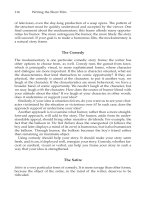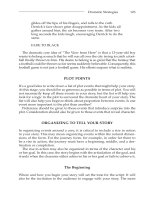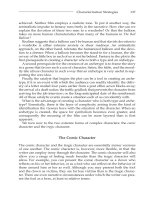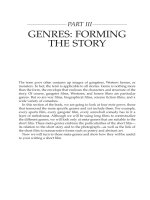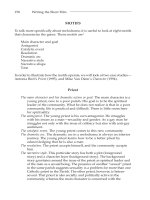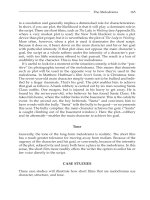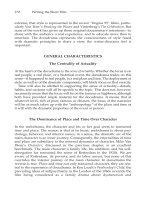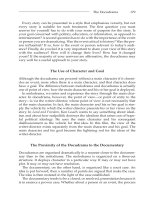Tài liệu Writing the short film 3th - Part 33 docx
Bạn đang xem bản rút gọn của tài liệu. Xem và tải ngay bản đầy đủ của tài liệu tại đây (146.12 KB, 7 trang )
and that might be too strong a term for the outcome of their relationship.
The young girl makes sure his appetite is satiated—she invites him home
for her grandmother’s authentic cooking. But beyond the cursory hanging
out together—visiting her grandmother in the hospital and so on—there is
no apparent arc to the relationship.
The Narrative Style
The young girl is happy and outgoing; the man is introverted and caustic.
Beyond that, we do not get to know either character very well.
Consequently, in the character layer of this story, there is no clear develop-
mental quality. Each character seems pleased about the relationship, but nei-
ther can go much further. There is no plot.
The Narrative Shape
Just as the characters seem suspended between epochs, time too seems sus-
pended. In any case, without linearity, time is not important in the narrative.
Tone
There is a cool, ironic tone to Autumn Moon. Although there are moments of
deep feeling—his confession to the Japanese woman about his inability to
feel, his cruel description of the preferable anatomy of her sister—more fre-
quently the film takes the point of view of voyeur, looking from the outside
in on these characters. His constant video filming supports this sense.
The stylized sense of the city—flat rather than deep—also abstracts the
sense of Hong Kong.
WRITING DEVICES
What Kind of Story Benefits from Experimental Narrative
Unconventional stories are the first source for experimental narrative.
Generally, the stories tend to be exploratory—stories of identity, stories of
alienation, meditations on a time or place. Vincent Ward’s film The Navigator
looks at a medieval period; Clara Law’s Autumn Moon looks at Hong Kong—
a place where change and tradition meet and, in the 1990s, conflict. Because
experimental narrative sidesteps plot, stories of character dominate. Because
the genre favors open-ended or nonlinear stories, the preference is for tone,
to make up for the absence of resolution.
214 Writing the Short Film
Ch16.qxd 9/27/04 6:11 PM Page 214
The Link to Poetry
Poetry may be nonrhythmic or rhythmic; it may relate to content, or it may
emphasize form. There is a freedom in poetry that surprises. It relates to the
organization of words—patterns—rather than to single images. It is the
same with experimental drama.
If you consider your drama as if it were a visual poem, you will strive for
the feeling of a relationship or place, or both, and not unduly re-reference the
story back to a conventional mode. The key with experimental drama is that
sense of liberation. You are doing something different, and when it works
you are a poet, working in the medium of film.
A Simple Idea
Large scale simply works against the experimental drama, so think in very sim-
ple, elemental terms. If you limit the parameters of the story and strive for a
feeling-tone, you will be on the right road for experimental narrative. Keeping
the idea simple—two people, a particular place—will help you limit the narra-
tive in such a way that you do not accidentally lapse into a more traditional
narrative. Experimental narrative does not require a lot of story, so simplify.
How to Use Character
Since plot is not a factor in the experimental narrative, the use of character
becomes very important.
On one level, the writer must keep a playful attitude toward character. The
man in Autumn Moon is depressed, and yet the way the writer-director
works with him produces an appealing side to him. It is important that the
female character is different from him in the story; the larger the contrast, the
better. In Autumn Moon, that character is a girl, 15 years old, as unspoiled as
the man is spoiled. The larger the gap, the more play enters the narrative and
the more creative the writer can be.
We also should be dealing with the characters in a personal way. We are close
to all these characters. They are vulnerable, and yet they remain somewhat
inscrutable. They are vulnerable and mysterious. The writer does not want us
to know these people any better than they know themselves. As they struggle
to understand, so do we. This is an important element of the charm of experi-
mental narrative. The narrative and the style are used to attempt to gain under-
standing of and insight into the character. Change may or may not happen, but
that is less relevant than the exploration itself, the internal struggle.
The Experimental Narrative 215
Ch16.qxd 9/27/04 6:11 PM Page 215
Finding a Structure
One observable aspect of the experimental narrative is that no two structures
are alike. We can say the story tends to be nonlinear, but beyond that, few
structures resemble one another.
There are shaping devices: A tourist from Japan comes to Hong Kong.
What will he find? Can he relate to the Chinese? He finds a Chinese girl, and
they strike up a relationship. That relationship is unpredictable. They must
use English to communicate rather than their own language.
In the above example, the relationship itself is the shaping device. In
Exotica, a place is the shaping structure. In Milcho Manchevski’s Before the
Rain, an idea—racial hatred kills love—is the shaping idea. Shaping devices
become a means to create a structure. The shaping device, however, is not
linear—ergo the unpredictability of the experimental narrative.
Tone and Voice
This is a form where your voice can be truly unique. The form, the substance,
the people, and the structure all will be interpreted through tone. The tone can
be poetic, ironic, or expressive, but it should be specific, to help us understand
why you are drawn to the characters or place of your story. The tone is the crit-
ical mode in which you will transmit your ideas and feelings, so in a sense, if
you choose the experimental narrative, it is your most important decision.
A CASE STUDY IN CHARACTER: SLEEPING BEAUTIES
In Karyn Kusama’s Sleeping Beauties (reprinted in Appendix B), two adoles-
cent sisters prepare for bed. They smoke a cigarette and share a fantasy
about a young man on a motorbike who will come and take them away.
They go to sleep. They hold hands, thereby acknowledging the love between
them. Such a motorcycle rider actually does appear, and the dominant sister
decides that the more modest sister should join him. She does so. The one
who is left behind feels abandoned. Her sister returns. They climb into the
same bed, but the dominant sister is unsettled. Was this a dream or an actual
occurrence? Was it the beginning of a rift in the relationship? Is fantasy an
antidote to the life they live at home?
The focus is on the two sisters. One is dominant, and the other is pliant—
a leader and a follower. But what happens to the relationship when the fol-
lower leaves? Will she return? Will the roles be reversed? These are the issues
that are explored in Sleeping Beauties. The male is simply “the male,” but the
two young women are given characters, if in a very polarized fashion. They
are not fleshed out beyond those extremes. The leader initiates—smoking,
216 Writing the Short Film
Ch16.qxd 9/27/04 6:11 PM Page 216
ordering the pliant sister to join the bike rider—and the pliant sister does as
she is told. Will this change? The ending is open-ended, unresolved, leaving
us with the puzzle—will she or will she not?
A CASE STUDY IN PLACE: EMPIRE OF THE MOON
Empire of the Moon, a short film by John Haptas and Kristine Samuelson (1991),
is about Paris. The point of view is that of the tourist—the tourist coming to
Paris, the tourist discovering the mysterious beauty of Paris, its inscrutable
quality. In order to capture the mystery of that beauty, the filmmakers use a
mixture of documentary images and abstracted images—parts of buildings, the
light of the moon moving across tree-lined residential areas, the artificial lights
of the tourist boats that peddle the story of Paris as they glide up and down the
Seine. Many of the great sites—the Eiffel Tower, the glass pyramid leading into
the Louvre, the Louvre itself, the beautiful train stations—all make up the
images of Paris. The tourists come from every corner of the world.
In order to shape their notion of Paris, the filmmakers use a variety of shap-
ing devices—five narrators, readings from Baudelaire and Gertrude Stein
about Paris, and the nature of the tourist—some happy to be photographed
as visitors, others probing, searching for some mystery, a formula that will
alter the part of their life they feel needs altering—art, relationships, ideas.
The key to this experimental narrative is that the beautiful mystery of
Paris, the Empire of the Moon, is inscrutable but valuable to each of us who
needs such a place in our lives.
A CASE STUDY IN STRUCTURE: RIVER OF THINGS
River of Things, a short film by Katharine and Mick Hurbis-Cherrier, is based
on four poems by Pablo Neruda. The filmmakers present four odes based on
the poems: an “Ode to Things,” an “Ode to the Spoon,” an “Ode to a Bar of
Soap,” and an “Ode to the Table.” The film is formally structured by these
four odes. Not all are similar in length or tone. “Ode to Things,” for exam-
ple, the most naturalistic of the four, is the only one to focus on a relation-
ship—of a married couple. It is also linear in its progression—it follows them
from the beginning of their day to its end. The poem itself forms their obser-
vational style of dialogue. Their dialogue about things is self-reflexive. This
is also the longest of the four odes. The next three odes are focused differ-
ently. “Ode to the Spoon” is less natural and focuses on the ironic dialectic
between functionality and artfulness. Although each of the episodes is play-
ful, this second ode drifts away from the naturalism of the first episode.
Spoons move on their own; they become animate. The pace of the second
ode is more rapid.
The Experimental Narrative 217
Ch16.qxd 9/27/04 6:11 PM Page 217
“Ode to a Bar of Soap” slows down. It remains playful but introduces fan-
tasy and absurdity into the act of the morning bath. Images of chocolate cake
and of a bar of soap transformed into an elusive fish in the tub make this
sequence the most nonnaturalistic of the four. But as in the first two, the nar-
ration is a voice-over. In the last of the odes, “Ode to the Table,” the narra-
tion is sung, as a choral piece. The goal is to make the table the hub for every
human activity—functional, sexual, artistic. Many people, a chorus of peo-
ple, participate around the table in order to give it the centrality the ode
implies. The tone is serious, sober, important. The playfulness is diminished.
The overall structure of River of Things comes from the Neruda poems. But
a secondary structure comes from the tone—a playful attitude toward the
narratives of each of the odes. Although the structure is loose, it is neverthe-
less present, and it shapes the rueful observation of Neruda with a tonal
appreciation of those elements in life that we ignore but whose functionality
Neruda and the filmmakers laud.
A CASE STUDY IN TONE: ECLIPSE
Jason Ruscio’s Eclipse (1995) is a short film that provides a powerful experi-
ence in tone. Set in an unspecified time and place, the only live character is
a young boy, age 12 or 13. Through the course of the narrative, there are a
series of flashbacks that tell us he is the sole survivor of a massacre. His
mother was killed by soldiers. Now, as he surveys the farm where he lived,
he sits by the pit where his mother died and finds a dead soldier. Holding
the soldier’s gun, he fantasizes about killing the man. Finally he leaves
home, following a railroad track until he is found by partisans and taken in.
The tone of Eclipse is elegiac, and is principally about loss. Its nonspeci-
ficity with respect to any historical time and place allows us to roam and to
believe it is about Bosnia or the Holocaust. In fact, the tone allows us to
generalize and speculate about all tragic loss, historical or current. The film-
maker takes a formal approach to his images. The consequence is that it cre-
ates two rituals—one for loss, the other for the will to live. Eclipse is a
powerful, wordless film that remains with the viewer for a long time. The
tone is the central reason for its power.
A CASE STUDY IN VOICE: ALL THAT’S LEFT: SPECULATIONS
ON A LOST LIFE
Katharine Hurbis-Cherrier’s All That’s Left: Speculations on a Lost Life gives us
an opportunity to focus on the most lingering aspect of the experimental
218 Writing the Short Film
Ch16.qxd 9/27/04 6:11 PM Page 218
